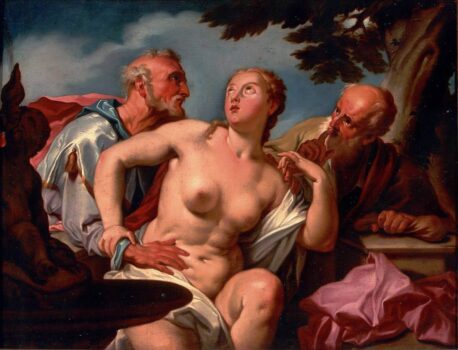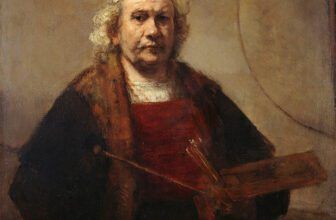What are Famous Paintings by Orazio Gentileschi
In the golden age of Baroque art, when chiaroscuro shadows danced across canvases and religious themes found visceral intensity, one man wielded his brush with grace and refinement, Orazio Gentileschi. Often overshadowed by the towering presence of Caravaggio and by the rising fame of his daughter, Artemisia Gentileschi, Orazio carved his own elegant path through the turbulence of 16th- and 17th-century Europe. His name may not be whispered as loudly as others in museum corridors, but the legacy he left behind gleams as luminously as the delicate silk he so often painted.
This is the story of Orazio Gentileschi, his life, his most famous works, his enduring influence, and the locations where his art continues to captivate modern viewers.
The Life of Orazio Gentileschi
Born in 1563 in Pisa, Italy, Orazio Lomi Gentileschi entered a world of shifting religious ideologies, rising artistic fervor, and political upheaval. He was trained in the Mannerist tradition, heavily influenced by the late Renaissance, but his style would later evolve under the influence of Caravaggio, embracing the Baroque’s realism and emotional intensity.
By the late 1500s, Orazio had moved to Rome, where he built his career amid one of the most competitive and artistically rich environments in Europe. Rome at the time was undergoing a spiritual and visual transformation, driven by the Counter-Reformation, which called for emotionally resonant and didactic art to reaffirm Catholic faith.
It was here that Orazio encountered Michelangelo Merisi da Caravaggio, whose revolutionary use of naturalism and dramatic lighting would profoundly impact him. Although never an imitator, Orazio absorbed Caravaggio’s lessons, reinterpreting them through his own lens, a lens of elegance, grace, and serenity.
Style and Substance: What Is Orazio Gentileschi Known For?
While Caravaggio was known for brutal realism and raw emotional power, Orazio Gentileschi distinguished himself with a more refined and lyrical approach. He embraced chiaroscuro but tempered it with grace. His compositions often featured serene expressions, flowing garments, and a gentle softness, especially in the depiction of women.
Orazio is particularly known for:
Delicate drapery and fabrics: His ability to paint silk, satin, and lace with extraordinary realism became one of his signature traits.
Elegant figures: His human figures, especially women, were idealized yet emotionally expressive.
Religious and mythological themes: He often explored stories from the Bible or classical mythology, bringing them to life with human warmth and dignity.
Collaborative and court work: He painted for major courts in France and England, adapting his style to suit aristocratic tastes.
Orazio and Artemisia: A Complicated Legacy
One cannot explore Orazio’s story without mentioning Artemisia Gentileschi, his daughter and perhaps the most renowned female painter of the Baroque era. Orazio personally trained Artemisia, and her early works reflect his stylistic influence. However, their relationship was strained, particularly after the infamous rape trial of Agostino Tassi in 1612, in which Orazio defended Artemisia.
Despite personal turmoil, both father and daughter pursued their careers vigorously. Artemisia eventually forged her own independent reputation, while Orazio continued to rise in prominence across European courts.
Famous Paintings by Orazio Gentileschi
1. Judith and Her Maidservant with the Head of Holofernes (1611–12)
Location: Palazzo Pitti, Florence
This painting showcases Orazio’s interpretation of the dramatic Biblical story. Unlike Caravaggio’s gory and intense version, Orazio’s Judith is calm and noble, clothed in luxurious fabrics with a golden glow highlighting her face. The moment is one of cautious retreat rather than violent action, and it’s painted with an attention to texture and composition that is distinctly his own.
2. Danaë (1623)
Location: J. Paul Getty Museum, Los Angeles
Commissioned by the Duke of Buckingham, this sensual painting of Danaë, visited by Zeus in the form of golden rain, exemplifies Orazio’s mastery in painting fabric and flesh. The gold coins tumbling from the sky illuminate the scene in a celestial glow, bathing Danaë in divine light.
3. The Lute Player (1612–15)
Location: National Gallery of Art, Washington, D.C.
A serene woman, lost in the music of her instrument, is depicted with meticulous attention to detail. The folds of her dress, the reflective surfaces of the lute, and the softness of her expression make this one of Orazio’s most lyrical works.
4. The Annunciation (1623)
Location: Alnwick Castle, Northumberland, UK
In this painting, the Archangel Gabriel appears before the Virgin Mary in a scene rendered with supernatural calm. The light bathes both figures with divine purity. Orazio’s interpretation is not about grandeur but about intimacy and stillness.
5. Rest on the Flight into Egypt (1628)
Location: Galleria Doria Pamphilj, Rome
This peaceful moment in the Holy Family’s journey features Joseph, Mary, and the infant Jesus resting in a quiet forest. The lush landscape, gentle postures, and exquisite fabrics are all typical Gentileschi touches.
How Many Paintings Did Orazio Gentileschi Create?
Orazio Gentileschi’s surviving output is relatively modest compared to some of his contemporaries. Scholars attribute around 80 to 100 works to him, though some are debated. His meticulous technique, preference for high-profile commissions, and later courtly environment may explain the limited volume. However, what he lacked in quantity, he more than made up for in quality and refinement.
The Most Expensive Painting by Orazio Gentileschi
The current record for the most expensive Orazio Gentileschi painting is held by “Danaë,” sold in 2016 to the Getty Museum for an estimated $30 million. Though private sale figures are not always disclosed publicly, the acquisition by the Getty was significant not only for its price but for what it represented: a major institutional recognition of Orazio’s enduring value.
Danaë exemplifies the pinnacle of Gentileschi’s artistic skill and appeal to modern collectors. The mix of myth, sensuality, and technical brilliance make it a masterwork that continues to attract scholarly and commercial interest.
Where Are Orazio Gentileschi’s Paintings Located Today?
Today, Orazio’s paintings are housed in major museums and private collections around the world. Some key locations include:
J. Paul Getty Museum (Los Angeles) – Houses “Danaë.”
National Gallery (London) – Features “The Finding of Moses.”
National Gallery of Art (Washington, D.C.) – Home to “The Lute Player.”
Museo del Prado (Madrid) – Holds works like “Saint Cecilia and the Angel.”
Palazzo Pitti (Florence) – Features several works including Judith-themed compositions.
Galleria Doria Pamphilj (Rome) – Holds religious-themed works.
Alnwick Castle (UK) – Home to “The Annunciation.”
Private collections in the UK, France, and Italy – Some of his court commissions remain in noble collections.
Orazio’s time spent at the courts of the House of Savoy in Turin, Marie de’ Medici in Paris, and Charles I in England resulted in an international footprint that still defines his art’s geographical spread today.
Later Years and Death in England
In 1626, Orazio moved to England to serve as court painter to Charles I, who was an avid art collector and patron. There, Orazio worked on large decorative commissions, including ceiling paintings at Queen’s House in Greenwich (now part of the Royal Museums Greenwich). His elegant style was perfectly suited to the tastes of the English court.
He died in 1639 in London, at the age of 76, respected and successful, a rarity among artists of his era.
Orazio Gentileschi’s Legacy
Orazio’s legacy is often intertwined with that of his daughter Artemisia, but his individual contributions to Baroque painting are distinct and essential:
Refinement in the Baroque idiom: Orazio softened the edges of Baroque’s emotional ferocity, offering a version that emphasized elegance and composure.
Bridge between Mannerism and Naturalism: He represents a transitional figure who gracefully merged the stylized beauty of Mannerism with the grounded realism of the Baroque.
Influence on Courtly Art: Orazio helped shape the visual language of courtly portraiture and religious art in England and France.
Master of Drapery and Detail: His paintings remain unmatched in their rendering of luxurious fabrics and tender expressions.
More recently, renewed scholarly attention and high-profile exhibitions have helped reposition Orazio as not merely “Artemisia’s father” or “a Caravaggisti,” but as a master in his own right.
The Quiet Power of a Baroque Master
Orazio Gentileschi may not have stormed into history with the fury of Caravaggio or the dramatic narrative of Artemisia, but his art offers something more enduring, a vision of beauty, calm, and introspective grace. In a world often obsessed with excess, Orazio chose restraint. In a time of turbulence, he painted serenity.
His story is one of perseverance, adaptation, and masterful artistry. Today, when we walk through galleries and behold the silk folds of Danaë’s robe, or the gentle hand of Judith parting a curtain, we witness not just scenes of myth and scripture, but the careful touch of a man who saw the world as a place of both divinity and delicacy.
In Orazio Gentileschi’s world, light is never harsh, beauty never boasts, and silence speaks volumes.




